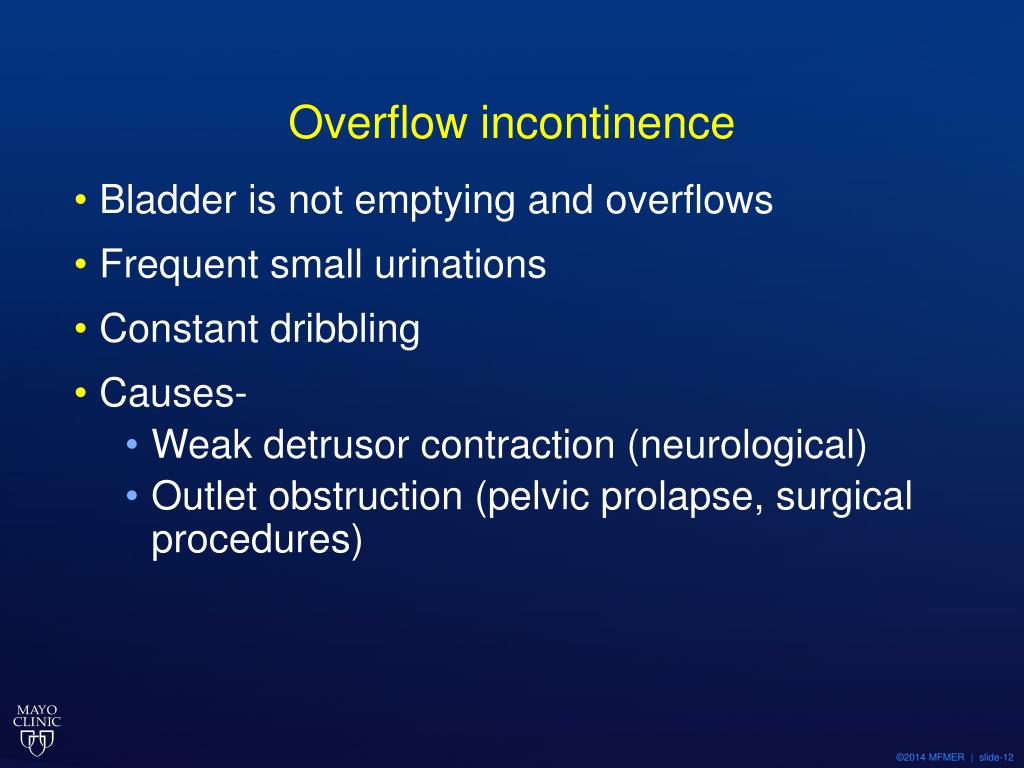
TREATMENTS FOR OVERFLOW INCONTINENCE FULL
They are ultra-thin and absorb up to a full bladder’s loss of urine, locking it away in an absorbent gel core to keep you dry and comfortable. This type of incontinence is best remedied by wearing incontinence products like Always Discreet underwear. If a physical or cognitive disability prevents you from getting to the bathroom on time, you may have functional incontinence. Learn more about overflow incontinence causes and treatment options. As a result, urine leaks out when pressure or stress is exerted on the pelvic floor during everyday activities like coughing, sneezing, laughing, exercising or during sex.

These muscles help control the urinary sphincter, which is responsible for closing off the bladder and regulating urine flow. Stress urinary incontinence is the result of a weakened pelvic floor-the system of muscles, ligaments and nerves that supports your bladder, uterus and anus. There are five main types of urinary incontinence: stress, urge, overflow, functional and total. The symptoms of urinary incontinence in women depends on which kind of incontinence you may have. So, if you experience little leaks or gushes, you are not alone. In fact, one in three women ages 35 and older experiences incontinence. There is a common misconception around incontinence-that it’s an affliction of the elderly. With a little management, you can live a life filled with the activities you love despite experiencing incontinence. Or perhaps even a short run to the store-away from a bathroom-can become a source of anxiety. Maybe they stop doing much-enjoyed physical activities like aerobics, tennis, dancing or gardening, due to incontinence. Maybe they are afraid of an embarrassing accident while out with friends, so they opt to stay home. Many women with urinary incontinence stop doing certain activities as a result of their bladder leaks. How Incontinence Goes Beyond Bladder Leaks “Sensitive bladder” is a term that many women liked and related to. Why do we say, "sensitive bladder"? We asked many women what they think is a good way to describe their urinary incontinence issues. It can mean increased urgency, frequency of urination or both. There are lots of ways to describe the same thing and this bladder control condition goes by many names and terms including urinary incontinence, sensitive bladder, overactive bladder, weak bladder and bladder leaks.įor example, the term “sensitive bladder” describes a common condition that can also be described as frequent urination in women. So how is incontinence different from “bladder leaks” or a “sensitive bladder?” Short answer is that there isn’t much of a difference.

This can range from occasional little leaks when you cough, laugh or sneeze to an urge to urinate that comes on so strongly that you don’t make it to the bathroom on time. Put simply, urinary incontinence is the loss of bladder control. So, let’s start with a definition of terms.
TREATMENTS FOR OVERFLOW INCONTINENCE HOW TO
Here we'll review the main kinds of urinary incontinence in women, their causes, symptoms, treatment options and how to best manage incontinence. More than one in three women over the age of 18 are dealing with incontinence of some kind-and there are different types of incontinence you can experience. Urinary incontinence is more common than you think. This can range from little leaks to full bladder voids. Urinary incontinence occurs when urine is released from the bladder involuntarily.


 0 kommentar(er)
0 kommentar(er)
